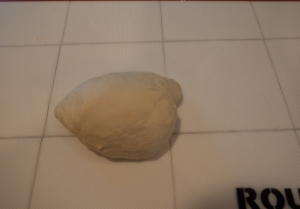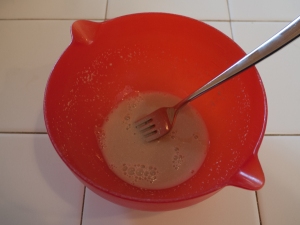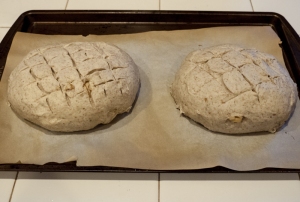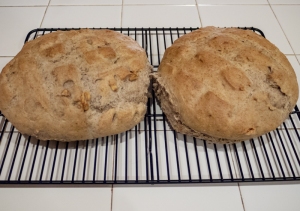
Hveder are Danish holidays rolls, literally ‘Wheats’ eaten at ‘General Prayer Day’ (Store Bededag). It is a holiday dating from 1686 as a collection of a number of minor Roman Catholic holidays which survived the Reformation (the transition of Denmark from a Roman Catholic country to a Protestant country), merged to one day. It is held on the 4th Friday after Easter, and is a bank holiday – everything is closed.
Most people in Denmark are not very avid church goers, but as Danish Protestantism is the state church, most people belong to it, and does some observations of the holidays, regardless of how much of the faith the choose to include in the celebrations.
When the holiday was introduced, work, travel, trade, gambling and play was forbidden, which meant bakeries was closed. Bakers would bake these rolls for people to buy Thursday evening for the next day. Today, most people eat them fresh Thursday evening as well as Friday morning, and they are great toasted.
The Hveder themselves were a specialty for a long while, and probably not common in the average population even when the holiday was introduced. Most people ate rye breads, as wheat did not grow well in most of Denmark due to the cold climate. It was only later more hardy species of wheat was introduced, and it was still an expensive specialty. Besides being made from wheat, the rolls also are made with butter, egg and milk, so they are an enriched bread, though not as much as challah or brioche.
This year, the Danish newspaper Politiken ran an online article (source of most of this information!) on them, with a bunch of recipes. I decided I should make some, even if the holiday had long past.
Ingredients: (Original in Danish from politiken.dk)
- 500g bread flour* (17.6 oz, about 4.2 cups)
- 100 ml milk (0.4 cups)
- 100 ml water (0.4 cups)
- 50g butter (about 1/2 stick)
- 50g yeast cake (3 tsp active dry yeast)
- 1 tsp salt
- 1 tsp sugar
- 1 egg
- 2-3 tsp ground cardamom
- milk for brushing
*Though you don’t normally use bread flour a lot in Denmark, it is well suited to these rolls, as they are meant to rise a lot.
Method:
1. Gently melt the butter and mix in the milk and water. Transfer to a mixing bowl and let stand until lukewarm ( 90-100 F / 32-37 C).

2. Beat the egg together.
3. Add the yeast to the lukewarm butter, milk and water mixture and mix well until dissolved.

4. Mix in the sugar, flour, salt, cardamom and egg.

5. Transfer dough to a work surface and knead well, about 5 min or more. This dough does not have a high water content, so it will feel a little hard.

6. Form a ball and place in the bowl, cover with film and let stand to rise until doubled, about 30 min.

7. Punch down dough and knead well again.

8. Spilt the dough into 12 equal pieces, and form small rolls from them.

9. Place the rolls fairly close together on a baking sheet, they should be touching when they are done rising. I ended up with mine just a little too far apart. Let rise for 20-30 min more.

These ended up a little too far apart
10. Preheat oven to 390 F/ 200 C. If your oven is part of your stove, it is great to let the rolls rise on top of your stove for some extra warmth.
11. Brush the rolls with milk.

12. Transfer to oven and bake for 20 min, until risen and golden.
13. Let cool and break apart to eat. Toast well if you eat them the next day.

Someone couldn’t wait
I was happy with how these turned out, it is an easy luxury bread. They are traditionally a little more square, but they were well risen and delicious.

























































